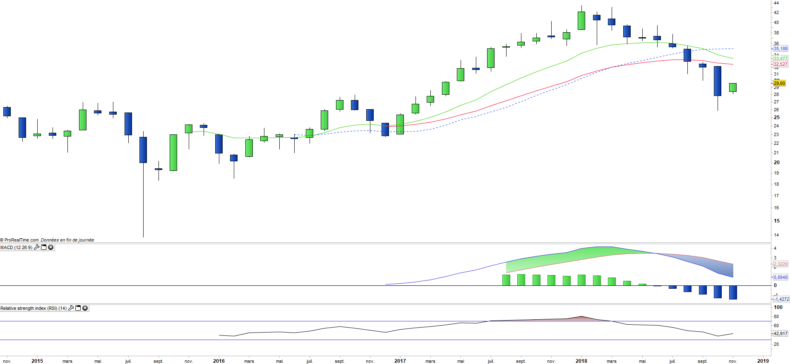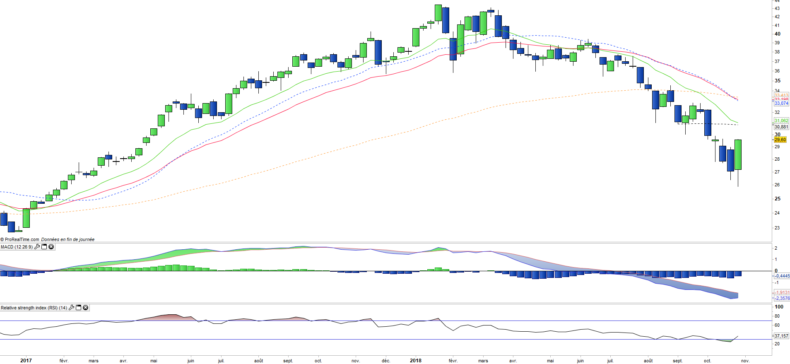Emerging Markets internet & e-commerce (EMQQ) - 02/11/2018
Short Term strategy: Negative (20%) / Trend +
Long Term strategy: Negative (30%) / Trend -
Characteristics of the ETF
The ETF EMQQ (ETC) replicates a market capitalization-weighted index of companies operating Internet-related businesses in emerging and frontier markets. EMQQ is a specialized fund comprised of emerging market Internet and technology stocks, exclusively listed in the United States. These companies are generally specialized in online sales, e-commerce and gaming. Unsurprisingly, Chinese companies represent a significant part of EMQQ's weighting. The fund is weighted according to market capitalization, but with a limit of 8% for each security at the time of the reconstitution of the list in June and December, and is quite concentrated on the ten most important securities, in particular Tencent, Alibaba and Baidu.
Fees are 0.86% and AUM are $ 367M. Replication is direct and there is a dividend policy on an annual basis.
Alternative ETFs: N / A
Index & components
EMQQ gives access to 59 specialized Internet and e-commerce securities, which originate from China for c.61%, South Korea for 11%, Russia for c.6% and South Africa for c.7% but which also include companies from India, South America, the Middle East and Eastern Europe.
The top 10 companies account for nearly 61% of the market capitalization of the index, which includes the 3 heavyweights Alibaba, Tencent and Baidu whose market capitalization is just like the GAFAs of several hundred billion dollars.
Companies selected in EMQQ are required to engage in e-commerce or Internet activities and include search engines, online retail, social media, online video, electronic payments, online gaming, and online travel activities. In 2025, the consumer society will reach 4.2 billion people against 2.4 billion in 2010 and 1.2 billion in 1990. Consumption in emerging countries will then represent 30 trillion dollars - almost half of the total world consumption. The transformation of purchasing behavior through the use of the Internet is deeply felt in emerging markets, whose embryonic middle classes are developing rapidly.
The falling costs of smartphones and bandwidth allow for increasing internet access in developing countries, both in rural and urban areas. Today, there are about 2 billion smartphone users worldwide. By 2020, this number is expected to double to over 4 billion, which will transform purchasing behavior, which should in the first place allow e-commerce to benefit from growth in emerging markets consumption.
Due to a relatively undeveloped retail sector in emerging markets, it is easy to imagine that online sales could represent a larger proportion of retail sales in emerging markets than in developed economies. The vast majority of emerging market consumers do not own cars or computers, do not shop in supermarkets, and do not have an internet connection. E-commerce companies therefore allow emerging-market consumers to "jump" a step, switching directly to next generation consumption from a smartphone.
Latest developments
EMQQ recorded an increase of + 66% in 2017, but consolidated more than 22% since the beginning of 2018 in the wake of the "BAT" and in particular Tencent which consolidates by 28%.
This fall is related to the increase in trade tensions between China and the US that directly threaten the Chinese economy highly dependent on exports while EMQQ is essentially a bet on the Chinese consumer, which also implies a high exposure to the China's overall economy.
However, e-commerce is growing at a high speed in China where the Wechat messaging now has 1 billion active users and Tencent has made this instant messenger, installed on just about every mobile phone in China, a platform form of entertainment and games stimulating all of its activities. The residual potential of this industry in emerging countries seems considerable and not only in China, while 40% of the index is made up of non-Chinese companies.
Monthly data
The monthly chart shows a bearish reversal, which is expressed by prices that are below all moving averages and a reversal of the MACD. However, EMAs13 and 26 have not crossed to the downside and the MACD remains above its zero line so there is still a possibility of a return to an uptrend, but for that it would be necessary for the prices to go back over the $ 35. The candlestick that begins in November is bullish, but not enough to change the technical situation.
Weekly data
On the weekly chart, we can see the brutality of the mid-term downward reversal since the beginning of the year. A rebound is in formation this week that forms a bullish engulfing, that could allow an extension of the rebound to the EMA100 located around $ 33 or more than 10% above current levels. This rebound will have to cross the EMA100 on the rise so that we can consider a bullish reversal.
ETF Objective
Characteristics
| Inception date | 12/11/2014 |
| Expense ratio | 0,86% |
| Issuer | ETC |
| Benchmark |
NYSE Arca
|
| Code/Ticker | EMQQ |
| ISIN | US3015058890 |
| UCITS | No |
| EU-SD Status | Yes |
| Currency | Dollar |
| Exchange | NYSE |
| Assets Under Management | 367 M$ |
| Currency Risk | Yes |
| Number of Holdings | 43 |
| Risk | 4/5 |
Country Breakdown
| China | 61% |
| South Korea | 11% |
| Russia | 7% |
| South Africa | 7% |
| Argentina | 6% |
| Others | 8% |
Sector Breakdown
| Information technology | 79% |
| Consumer discretionary | 12% |
| Industrials | 1% |
Top Ten Holdings
| Tencent Holdings | 7% |
| Alibaba Group | 7% |
| Naspers Ltd | 7% |
| Baidu Inc | 7% |
| Netease | 6% |
| Mercadolibre | 6% |
| Ctrip.com | 5% |
| Netease | 5% |
| Naver Corp | 5% |
| Yandex | 4% |
[/groups_member]


